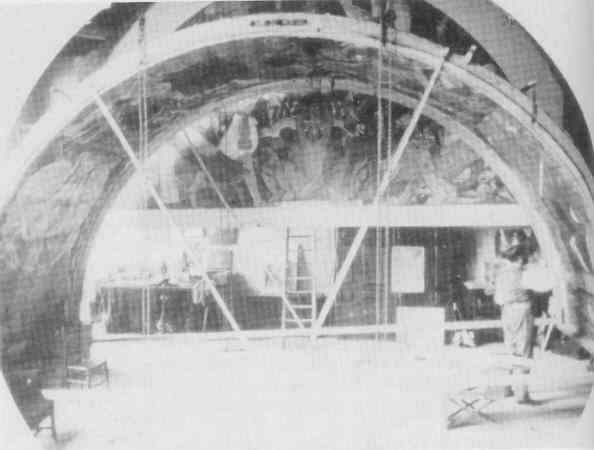
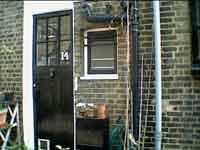 Studio no14 rear entrance
Studio no14 rear entrance

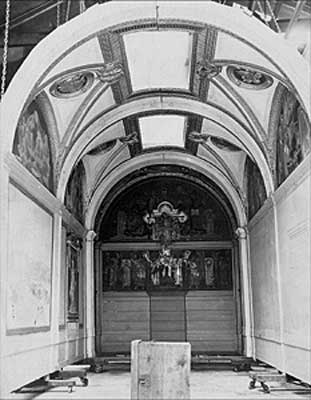 One third scale
model of the Boston Library
One third scale
model of the Boston Library
Fulham Road Studio
Photo
Jpg: sargentmurals.bpl.org
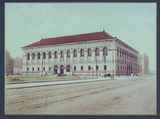
The
Boston Public Library
|
London Directory
The Avenue
76 Fulham Road
1902
(Earliest
directory on the shelf at Kensington Library)
No.1A
Miss Gwenny Griffiths, artist
No.2 George Edward Wade, sculptor
No.3 Sir Edward John Poynter P.R.A., artist
No.3A George Wilson, sculptor
No.4 Miss Frances Fairman, artist
No.5 John Henry Monsell Furse, sculptor
Nos.6 & 8 Henry Charles Furse, sculptor
No.7 Miss Fortunée De Lisle, artist
No.9 Miss Mabel Young, artist
No.10 Albert Toft, sculptor
No.11 Trevor A. Batty, artist
No.12 & 14 John Sargent, artist
No.15 H. Harris Brown, artist
( . . . ) 1916
No.1A Miss Annie Louise Swynnerton, artist
No.1 George Edward Wade, sculptor
No.4 Lionel Fritz Roselieb
No.5 Miss Gwenny Griffiths, artist
No.6 Henry Charles Fehr, sculptor
No.8 John Tweed, sculptor
No.9 Miss Mabel Young, artist
No.11 Julius Olsson ARA JP, artist
1917
No.1A Miss Annie Louise Swynnerton, artist
No.1 George Edward Wade, sculptor
No.4 Lionel Fritz Roslyn
No.5 Miss Gwenny Griffiths, artist
No.6 Henry Charles Fehr, sculptor
No.8 John Tweed, sculptor
No.9 Miss Mabel Young, artist
No.11 Julius Olsson ARA JP, artist
1918
No.1A Miss Annie Louise Swynnerton, artist
No.1 George Edward Wade, sculptor
No.4 Lionel Fritz Roslyn
No.5 Miss Gwenny Griffiths, artist
No.6 Henry Charles Fehr, sculptor
No.7 Ronald Gray, artist
No.8 John Tweed, sculptor
No.9 Miss Mabel Young, artist
No.11 Frederick Pegram, artist
No.11 Nicolas Faberge, artist
1919
Volume missing
1920
No.1A Miss Annie Louise Swynnerton, artist
No.1 George Edward Wade, sculptor
No.3 Miss Flora Lion, artist
No.4 Lionel Fritz Roslyn
No.5 Miss Gwenny Griffiths, artist
No.6 Henry Charles Fehr, sculptor
Nos.7&8 John Tweed, sculptor
No.9 Miss Mabel Young, artist
No.10 Montague Barstow, artist
No.11 Frederick Pegram, artist
No.11 Nicolas Faberge, artist
Very
little excitement there, then, apart from Mr Roselieb who
doubtlessly changed his surname to Rosslyn to try and sound less
Germanic.
|
|
Fulham
Road Studio
(12–14 The
Avenue, Fulham Road)
(located at 76 Fulham Road within Sydney
Close)
Interior Photo
In his Fulham Road
studio,
Sargent could
spread out and "paint nothing but Jahovah," or the murals for the
Boston
Public Library which wouldn't fit at all in Tite Street.
Here, you can see
how he had constructed
a framework to duplicate the barreled ceiling of the Library and would
hold the canvases in their concaved shape.
Sargent entered
into the lease towards
the end of 1895 after the first installation -- effectively moving from
Morgan Hall where he and Abbey worked together. Now on his own, with
Abbey's part of the project over, he would keep this studio for the
next
twenty-one years -- pretty much over the whole remaining span of his
library
decoration project.
From '95 on,
according to Charteris,
John would be working here more than at Tite Street. It served as his
hide-away
of sorts as he had grown so popular he could rarely get
any privacy at Tite Street.
[The Avenue studio was a large
space] with an adjoining room where he worked at the
architectural part of his decorations . . . They were removed from the
thoroughfare with an unwelcoming approach through a back yard. Here he
would withdraw from the world, like a bandit to his fastness, and admit
visitors or not as he liked. An unanswered rap on the door was no proof
that Sargent was not within. If he answered, it was invariably in his
short-sleeves, generally with a cigarette in his mouth, and always with
a robust welcome. Scores of pencil studies lay about and vast canvases
were in position against the wall, with regards to these he was always
curious to hear the views of a layman, and ready to discuss his
criticism and approval. The contents of his workshop next door, where
he worked out problems of lighting and calculations of architecture
proportion and geometrical relations, were much more recondite; here
the amateur could only display a totally unintelligent interest. His
famous picture 'Gassed' was painted at Fulham
Road, also the 'Generals of the War' and the
decorations of Boston.
(Hon. Evan Charteris, K.C.; John Sargent; Benjamin Blm, Inc.
1927; p.155)
From: Scott Thomas
Buckle
scott bu c kle@btopenworld.com
Date: Sun, 13 Mar 2005
The
Avenue, 76 Fulham Road was collectively a group of studios favoured by
artists and sculptors in the latter part of the nineteenth century.
Originally
it was built as a
studio and foundry for Baron Carlo Marochetti who lived just behind at
34
Onslow Square from 1849 till his death. Marochetti was a well-known
sculptor and one of his notable works was a collaboration with Sir
Edwin Henry
Landseer on the lions
which sit at the base of Nelson's Column in
Trafalgar Square. After
Marochetti’s death in
1867, the Avenue was divided into smaller individual studios.
(Sydney
Mews)
In
the 1880s the Avenue became the working address for painters
that
included
William Linnell, Edward John Poynter (later President of
the Royal
Academy between 1896-1918) and Charles Edward
Hallé [1], the
co-founder of the Grosvenor and New
Galleries where Sargent exhibited.
Sir Joseph Edgar Boehm, Sculptor in Ordinary to Queen Victoria had his
studio there, as did his pupil Alfred
Gilbert [off site] and his
follower Edward
Onslow Ford [off site]. It was
at no.8 the Avenue that Gilbert worked on his most famous work, the
Shaftesbury Memorial, commonly known as ‘Eros’ which was completed in
1893. Sargent
took a lease on a studio at the Avenue two
years later in '95, his Tite Street residence proving unsuitable
for mural work. Elizabeth McAllister in her 1929 biography of Gilbert
says that Sargent took over the sculptor’s studio [no.8 The Avenue],
although most sources say that Sargent occupied nos.12 and 14, no.12
being the studio formerly used by the painter Matthew Ridley Corbet
from 1887 onwards. Gilbert befriended Sargent, enlisting his service to
contribute to the 1895 Centennial Exhibition of Lithography in Paris.
Years later Gilbert presented Sargent with a cast of Victory, a favourite gift for his closest
friends. Understandably, Sargent’s continuing work on the murals for
Boston Library took on a sculptural effect. He made studies for the
figure of Moses using the Italian model Angelo Colarossi, father of the
boy who modelled for Gilbert’s Eros. At his studio in Fulham Road,
Sargent built a one third
scale model of the Boston
Library commission to help him envisage the scheme as it developed, the
whole structure assembled on wheels and moved about the studio by means
of a system of chains and pulleys.
Sargent continued using
the Fulham Road studio for more than twenty years. He lent it briefly
to Whistler in early 1896, ten years after he
himself had moved into Whistler’s old studio at 31 Tite Street. The
larger studio at Fulham Road also afforded Sargent the privacy that
eluded him at his home half a mile away. In later years Sargent’s neighbours at the Avenue would include the
infamous occultist Aleister
Crowley, who would have Masonic meetings at his apartment at studio
no.33.[2]
The Avenue Studios today
The
collection of 15 artists studios that were originally called 'The
Avenue' still survive today. The main entrance to 'Avenue Studios' is a
large black door located in Sydney Close, a quiet mews off the Fulham
Road and faces west.
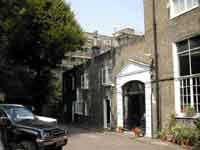
"The
Avenue" front entrance from Sydney Close
Looking northeast at west
elevation
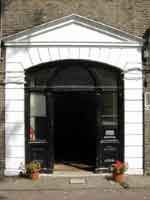
"The
Avenue" front entrance
The
door leads through to a long hallway with the doors to individual
studios
on either side along its length. Sargent used Nos. 12 and 14 for his
mural work and they are situated at the far end of the hallway on the
left.
The
back end of 'Avenue Studios' can be accessed via Sydney Mews, which is
a little
further along the Fulham Road. Each of the studios has a second door
which opens onto the mews wrapping the back of the building on three
sides. The odd numbered studios run along the south
side of the building which we are seeing here:

The
back end of 'Avenue Studios'
South Elevation, View looking West
At the east end of the building, or its rear, is No. 15 and No. 14 The
picture below shows the corner window of studio No. 14.
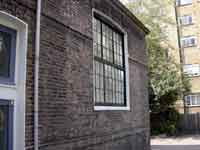
North east corner of 'the
Avenue Studios'
Studio No. 14 window
and around the corner, on the north side, are the even numbered studios
seen here:
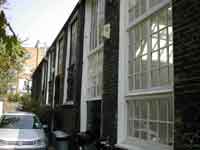
North Elevation, View looking
East
showing back entrances
The first of these from the rear is No. 14
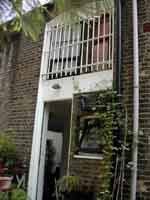
Studio No. 14 rear entrance

Studio No. 14 again on a
different day/month
and beside it to the right is studio No.12
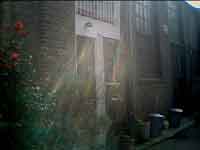
Studio No. 14 & 12
The following photograph shows studios (left to right) No.14, 12 and 10
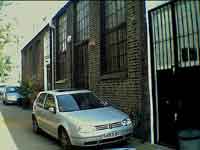
Studios No. 14, 12 and 10
A look through the window of a neighbouring studio . . .
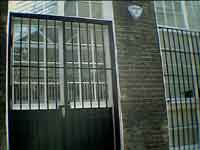
Studio No. 10
shows that the structure of the studios, particularly the ceiling
supports seems to be unchanged from Sargent's day or from even earlier
when the studios acted as a foundry for the sculptor Baron Marochetti.
Notes
Special
thanks to Scott Thomas
Buckle, of London, a
friend of the JSS Gallery, for all his help regarding the research
and photos for this page.
Sargent's Sudios
1)
C.E.Hallé,
who was to have his own studio in ‘the
Avenue’, writes this in his ‘Notes from a Painter’s Life’ (1909):
“…Baron Marochetti took me
in hand and I entered his studio as a pupil. I was then twelve years
old, and my work with him was much interrupted, as my people only spent
three months of the year in London, and I was not allowed to remain
there by myself; but during those three months I was every day at the
studio, a large block of buildings at the back of Onslow Square, now
the Avenue Studios…
…It was here that I
first met Thackeray, who lived next door to the
Baron on Onslow Square, and also Landseer, who executed the lions now
at the base of Nelson’s statue in Trafalgar Square in Marochetti’s
studio.”
2)
I realized that there is no
studio number 33 at the Avenue, although several websites affirm that
Masonic meetings were taking place there. Only one site corrects this
to No. 2 (website located here
under A.C. annotations to the Abbey p. 31) - I guess that Crowley
was up to some numerological trick with his mystical friends.
Other Sources
|
|
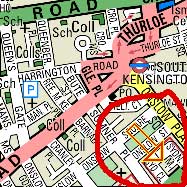
Map
Fulham Road & Tite Street
Studios, London

John
Ballantyne
British (1815-1897)
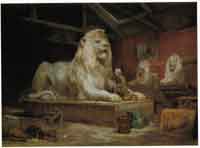
Sir Edwin Henry
Landseer
(Landseer's
lions)
c. 1865
(painted
at the Avenue studios during the sculpting of the Lions)

Alfred Gilbert
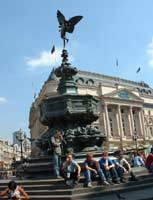
'Shaftesbury Memorial
The Angel of Christian Charity
"Eros"
1893


Map, Fulham Road & Tite Street
Studios, London
|

